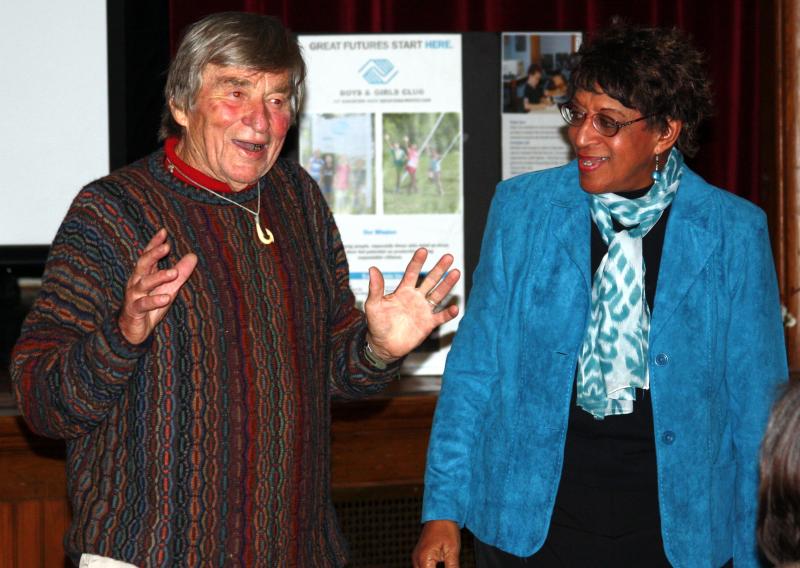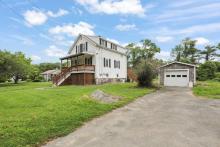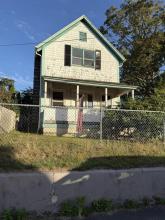Onset man shares what to expect on a 1,500-mile kayak trip
There are a lot of questions that arise when one plans a four-month long kayak trip across the Atlantic Ocean. What do you wear? What happens if you tip over? And perhaps even more importantly, when do you go to the bathroom?
The Boys & Girls Club of Wareham celebrated the 20th anniversary of Onset resident Richard Wheeler's 1,500-mile kayak trip from Newfoundland to Buzzards Bay with a November 3 showing of the 1994 NOVA documentary, "Haunted Cry of a Long Gone Bird," which chronicled Wheeler's journey.
The trip was Wheeler's effort to raise awareness about extinction and followed the migratory path of the extinct great auk, a flightless bird routinely killed by humans for its fat and feathers. He was 60 years old when he embarked on the trip.
After the showing, held at the Marion Music Hall in Marion, attendees got to learn the behind-the-scenes information that perhaps NOVA producers didn't include in the documentary. You know, like the bathroom thing.
"You don't really worry about it as long as you keep moving," said the now-81-year-old. (As soon as your feet touch land, he noted, you have about 30 seconds to find a bathroom...)
Wheeler talked about the logistics of the journey, which he spent a-year-and-a-half planning. His kayak was "jam packed" with charts, camera gear for the filming of the documentary, a three-to-four day supply of water, and lots of food, he said. A survival kit with supplies and a raft was also on-board.
Part of Wheeler's planning included discussions with the Coast Guard both here and in Newfoundland. He grappled with what to wear throughout the trip. He'd probably overheat in a dry suit. Wet suits offered their own pros and cons.
So, the Coast Guard told him: "Dress for the weather and make sure you don't tip over."
Considering the cold temperatures of the ocean water and the amount of stuff in the kayak, tipping over really wasn't an option, Wheeler said.
That survival kit also included next-of-kin information.
"I was motivated to stay right side up!" Wheeler said.
Event-goers also wondered where Wheeler slept. Did he camp? Did he know people he could stay with? It was about 50/50, he said.
With all the publicity surrounding the trip, including a Canadian radio show that updated listeners on Wheeler's whereabouts, he oftentimes had people waiting for him as he approached a town.
"They fought over me," he said of the Canadians, joking that Newfoundlanders practice "aggressive hospitality." "They fed me about every half hour!"
They called him "The Auk Man," he said, reiterating throughout the event that he was very grateful for the warm meals and the opportunities to sleep in a warm bed.
Though Wheeler sometimes had the company of nearby fishing boats, much of the kayaking portion of the trip was spent alone.
"Some of my worst moments lasted for hours," Wheeler said with a laugh before sharing what he called his biggest mistake of the trip.
He was about 17 miles away from St. John's, Newfoundland and was dealing with difficult waves. The sun was going down, but he decided that instead of stopping, he would take an unplanned shortcut to save himself some time later.
"For the first time in the whole trip, I had not researched the port I was going to go into," Wheeler said.
He was rounding an area with cliffs. He knew it was a popular fishing spot. But it wasn't what he'd expected.
"I found out, to my dismay, that there was no harbor," Wheeler said. People had fished by lowering boats down the cliffs and into the water, he later found out.
There was no where to stop. The only option was to continue to St. John's.
He arrived at 2 a.m.
"I was screaming for help," Wheeler recalled. But everyone was asleep.
"There wasn't anyone in the world who knew where I was," he said, adding that it was the first time he felt lonely on the trip. He was so exhausted that he didn't bother doing anything other than getting out of the kayak. He collapsed until dawn on a floating dive area.
"Boy," he told attendees, "that was really stupid."
Wheeler said the trip overall was a breathtaking experience. He was able to maneuver into areas that larger vessels cannot. With "Aukie," the wooden figurehead affixed to the bow of his kayak, he was able explore how and where the great auk lived. (The kayak is displayed at the Richard C. Wheeler Bay Learning Center at the Coalition for Buzzards Bay headquarters in New Bedford.)
"I sometimes felt like I was on the cover of an L.L. Bean magazine," Wheeler joked.
But would he do it again?
"I wouldn't swap that experience for $1 million... but I wouldn't do it again for $10 million!" he said.
The Boys & Girls Club and its avian mascot, Kukoo, have been hosting bird-related programs throughout the year as part of the "Kukoo for the Boys & Girls Club" fundraising campaign.
"You're an inspiration," Boys & Girls Club Wareham Unit Director Barbara Sullivan told Wheeler before presenting him with a Boys & Girls Club T-shirt.
For more information about the Boys & Girls Club of Wareham and its "Kukoo" events, visit www.kukoobgc.org.
Wareham Community Television (WCTV) will air "Haunted Cry of a Long Gone Bird" on Monday, November 7, at 7 p.m. on Comcast channel 97 and Verizon channel 28.











